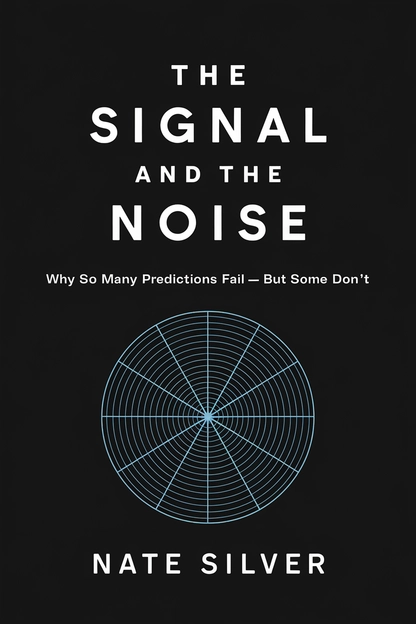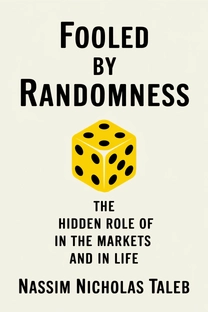
The Signal and the Noise
Why So Many Predictions Fail — but Some Don't
by Nate Silver
Brief overview
This book explores why forecasting often goes wrong and shows how sound reasoning increases our odds of making better predictions. It blends examples from sports, finance, and everyday life to show how scientific thinking and careful analysis can reduce uncertainty. By the end, readers will see how focusing on the right signals can help us navigate an increasingly noisy world.
Introduction
Imagine waking up each day certain the world follows a neat, predictable path, only to discover surprises around every corner. This book begins by challenging our assumption that more data or bigger databases automatically lead to perfect clarity. Instead, it argues that many of our forecasting failures reflect deep-seated human biases and an overconfidence in our own methods.
The story opens with stark examples of prediction gone awry—from economic crashes to unexpected events like terrorist attacks. These examples show how missing the obvious clues can lead to disastrous outcomes. Instead of condemning our attempts to see the future, the book invites us to explore how to face uncertainty with both humility and a more refined strategy.
This introduction sets the tone: even with all our technological capabilities, forecasting is a challenging craft. The author encourages us to move beyond simplistic formulas and become better judges of what is truly knowable—so that we can adapt and thrive in a world full of surprises.
Why Predictions Fail
Our tendency is to focus on the wrong details, to see patterns where none exist, or to ignore real warnings when they conflict with our biases. This chapter uses high-profile failures—like certain rating agencies overlooking glaring risks—to show that it is not just the quantity of data, but the clarity of thinking, that matters.
We learn that incentives often steer experts in biased directions. In the lead-up to financial collapses, for instance, professionals sometimes favored profitable deals over questioning fragile assumptions. This reveals a fundamental problem: when success depends on savvy marketing over true insight, predictions easily stray from reality.
Here, the reader is encouraged to ask: “Did these forecasters really have the wrong information, or were they reluctant to acknowledge the evidence?” By understanding the psychological and systemic reasons for failure, we can start to cure our overconfidence and sharpen our skepticism where it counts.
What is The Signal and the Noise about?
The Signal and the Noise by Nate Silver demystifies the world of prediction, dissecting why confident forecasts often fall apart. With captivating examples from sports, finance, and everyday occurrences, Silver reveals how a thoughtful blend of statistics and intuition offers clarity amidst information overload. Readers are challenged to reconsider assumptions about certainty, examining both the chaos of the unknown and the power of calculated analysis to discern meaningful signals embedded in the noise.
The book's unique contribution lies in its ability to turn complex scientific and data-driven concepts into accessible wisdom. It underscores the balance between empirical evidence and human judgment, showcasing the practical application of concepts like Bayes' theorem—an essential tool for updating beliefs logically in the face of new data. By deconstructing prediction failures and successes, Silver offers a roadmap for navigating the unpredictable, vital for anyone encountering real-world uncertainties.
The Signal and the Noise is essential for understanding how to sift through the excess of information in today's data-driven world. As predictive models evolve, this book equips professionals and decision-makers with strategies to identify genuine insights, make data-informed choices, and embrace the probabilistic nature of life.
Review of The Signal and the Noise
Nate Silver's The Signal and the Noise shines as a masterclass in data-driven storytelling, delivering profound insights into why predictions fail and how to sharpen them. Silver excels by scrutinizing key strengths of probability theory, demonstrating its practical application in separating vital signals from the distracting noise. Through engaging prose, he highlights the inherent limitations of over-reliance on big data, combined with an intelligent narrative that emphasizes intuition and empirical analysis.
One of the book's unique aspects is its lucid explanation of Bayesian principles, illustrating how to recalibrate beliefs as new data emerges. This approach is essential in fields like economics or weather forecasting, where precise predictions are elusive. Yet, Silver presents these complex concepts with an accessibility that invites even the statistical novice to follow along, making the material not only informative but also profoundly actionable.
Silver targets professionals and enthusiasts alike, from economists and data scientists to everyday readers keen on improving judgment regarding market trends or personal decision-making. His writing traverses from technical to casual fluidly, incorporating anecdotes without losing the essence of the content. For readers seeking practical insights into enhancing prediction accuracy, this book comes highly recommended as both an educational tool and a thought-provoking experience.
Who should read The Signal and the Noise?
- Economists and financial analysts looking to refine their predictive models through an understanding of probability and statistical tools.
- Data scientists and statisticians interested in applying Bayesian reasoning to extract meaningful trends from large data sets.
- Politicians and policy-makers needing to enhance decision-making processes through informed, evidence-based forecasting.
- Sports analysts and enthusiasts desiring to leverage statistical insights to make better bets or understand team dynamics.
- General readers passionate about improving decision-making skills and developing a critical approach to everyday predictions.
About the author
Book summaries like The Signal and the Noise
Why readers love Mindleap
10-Minute Book Insights
Get the core ideas from the world's best books in just 10 minutes of reading or listening.
Curated For You
Discover your next favorite book with personalized recommendations based on your interests.
AI Book ExpertNew
Chat with our AI to help find the best book for you and your goals.
Reviews of MindLeap
Love how I can get the key ideas from books in just 15 minutes! Perfect for my busy schedule and helps me decide which books to read in full.
Alex R.
The summaries are incredibly well-written and the audio feature is perfect for my commute. Such a time-saver!
Jessica M.
Great app for personal growth. The insights are clear and actionable, and I love how they capture the essence of each book.
Chris P.
The app is beautifully designed and the summaries are top-notch. Definitely worth every penny!
Sarah K.



